Raspberry variety Joan J (Joan J)
The first is the best?
Not so long ago, remontant varieties of raspberries became a real discovery for our gardeners, allowing them to see, and not only see - and eat plenty of berries, and even prepare them for future use in the year of planting. Repairers are greatly simplified in care and do not have problems with wintering, pests, diseases that have accumulated over the season - they cut it out after fruiting in the fall under "zero", and that's all, in the spring new powerful stems will crawl out of the ground. But I still wanted something more from them. Eh, if the thorns hadn't been there yet ... the summer residents sighed sadly, remembering the scratched hands in the battle for the harvest of delicious berries. And they smiled sadly, realizing that these were only crimson fantasies ...
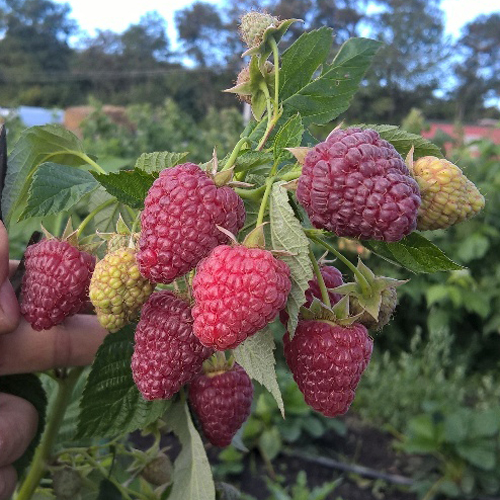
And so completely unexpected and revolutionary news, which immediately awakened the desire to possess this "miracle", was the appearance of the first studless remontant - Joan J. This "Briton" entered our market about 5-6 years ago, and many people who grow him still have him as their favorites.
Let's take a closer look at the history of its creation and characteristics in order to better understand why it is so popular, except for the absence of thorns.
Origin
Joan Jay is an English-bred remontant raspberry variety bred by the renowned scientist Derek L. Jennings as part of the Medway Fruits breeding program (in Maidstone, UK) in 2008. As a result of a laboratory experiment, a complex hybrid Joan Squire (Joan Squire) was crossed as a male plant, pollen was taken from him, and as a female plant, Teri Louise, which, after pollination, is the "parent" of seeds. From the subsequent controlled plantings in the soil in the fields, seedlings of a new variety were selected that meet all the necessary characteristics.
Description
Bushes of medium vigor, with a height of 1 to 1.5 meters. Stems are thick, powerful, well branched. The length of the sides is 50-70 cm, and the main thing is that on each of them full-fledged fruit branches are formed - laterals, as on productive varieties of summer raspberries. A big plus is that the shoots are absolutely smooth - without any thorns, light green, erect, but due to the high yield, they can bend to the ground, loaded with fruits. Therefore, it is highly desirable to use a trellis to obtain a full harvest and the placement of branches on it greatly facilitates the care of plants and the selection of berries. The leaves are large, with three or five leaflets and a deep pattern.
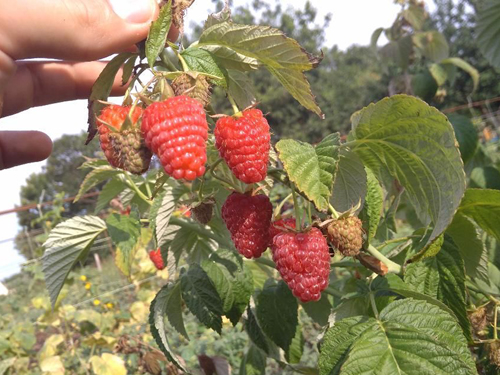
One of the indisputable and main advantages is excellent taste, one of the best among all repairmen. The berry is sweet, juicy, with a rich raspberry aroma. The sweetness persists in cool rainy weather. The berries are large, wide, elongated-conical, very even, bright red, rather even ruby, but darken when fully ripe.
They are easily separated from the fruit, with a dry separation. Drupes are homogeneous, small, well interconnected. Berries weighing 4-6 grams can go up to 8 grams. The average weight in the season is 5 g and throughout its entire length the fruits do not significantly shrink. The pulp is quite dense, elastic, but the skin itself is of medium strength. When ripe, they can hang on the bush without shedding for up to a week, but in the hot summer months, dark berries burn heavily in the sun, and this is considered one of the problems of Joan Jay's cultivation, especially for the southern regions. Way out - cultivation in tunnels covered with agrofibre, opaque film, or shading mesh over the plantation. But it is not convenient and affordable for everyone.
Ripening of berries occurs from the base to the tip, which demonstrates the degree of their ripeness, serves as a kind of indicator of readiness. For transportation and subsequent sale, it is advisable to take fruits with a light tip, well, but for personal consumption, canning, frosts are taken completely colored, in which all the wonderful aroma and rich taste are widely revealed.So the English originator of the variety for commercial purposes recommends a daily sample of fruits with an incompletely colored tip.
Yield
Joan Jay is a remontant of early ripening, bears fruit on the stems of the current year from the end of July, the main berry is in September, and in October it gives up its entire harvest. Now some gardeners have figured out yet another simply super-duper zest of this beautiful raspberry.
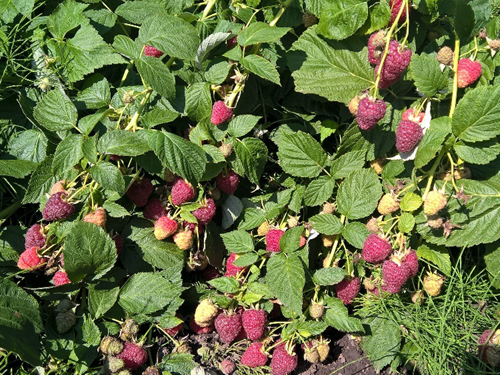
In late autumn or early spring, the trunk is not cut to zero, as is usual for agricultural technology, but by half or even less - up to 30 cm long. This provides a record ultra-early fruiting from the 20th of May to July, and then, after a very short break, new shoots are included in the work on the berry. It turns out an almost continuous berry conveyor, and the variety itself can be safely ranked among the real "tutimers", capable of giving a full harvest twice a season. The same technique with pruning is used on another fruit remontant "hit", albeit a blackberry one - Black Magic, but pruning is carried out higher - from 1 meter.
The variety is very productive! The declared yield is 16 - 19 tons (for the well-known and proven, practically reference remontant Polka, the yield is at the level of 8 - 10 tons). In our conditions, it is capable of giving up to 600 grams per shoot in the first year at early planting dates. The next year, the yield increases significantly and is already up to 1 kg, respectively. In terms of berries - about 100 pieces in the first year, and in the next up to 500, provided there is good branching (regrowth of the sides).
Root shoots Joan Jay gives a lot, which is great for those who are engaged in breeding for personal planting or selling seedlings, but you will have to normalize the number of stems in a row on fruiting plantings a little more often. Usually 10-12 pieces are left per running meter.
Other features
We list all the advantages of this raspberry: a thornless trunk, a very tasty, large and fragrant berry, excellent yield, the ability to fully bear fruit twice per season, suitable both for the fresh market and for processing, conservation and freezing, the ability to show good results already in a year planting, unpretentiousness, early onset of fruiting.
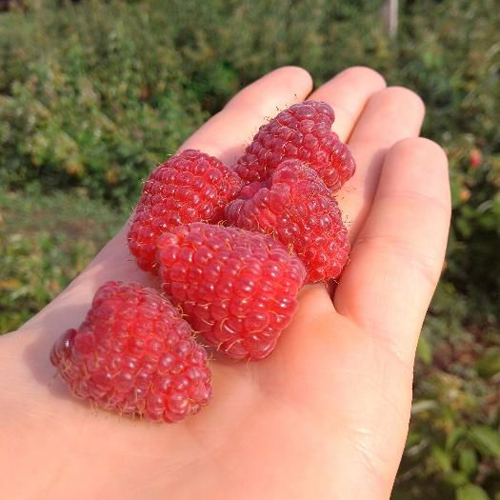
And some cons:
- Weak frost resistance of the variety (up to -16 degrees).
- The bush loaded with fruits is quite sprawling.
- Weak resistance to didimella (purple spot) with thickened plantings and high humidity.
- Poor keeping and transportability in fully ripe (dark red) berries.
I would like to say a few words about how to achieve good yields when growing Joan Jay's raspberries:
- Purchase quality, healthy seedlings from trusted vendors that can be found on whitelisting on horticultural forums.
- Preparation of landing pits. It is advisable to add about 5 liters of rotted manure, finely detailed organic matter (branches, bark
etc. ), not sour peat, a tablespoon of granular mineral fertilizers and mix it all well with the soil, spill it with water and let it settle a little. Later, all this will provide good nutrition to the plant for several years. - Mulching plantings with cut grass, straw, weeds without seeds, previously finely chopped. This technique allows you to retain moisture, protects the root zone from overheating in the summer months, improves soil structure and prevents weed growth. A layer of at least 10 cm is desirable.
- Spilling with preparations for ground pests: Antichrushch, Bazudin, Nurell, Aktara (in particular, from crustaceans, which can cause significant harm or even destroy the root system). If the seedlings are in pots, water before planting, the soil should be moist. If with an open root, then soak in a solution of the drug, followed by spilling after planting.
- Provide abundant and regular watering, preferably drip, despite the fact that Joan Jay is quite drought tolerant.
- Installing a trellis and then placing raspberries on it.
- Planting plants in 0.5-0.7 m with normalization of the number of stems as they grow back (10-12 pieces per linear meter) in order to avoid thickening, which affects the size of the berries and the condition of the plants themselves.
- Row spacing from 2 to 3 m for easy maintenance.
- Regular feeding of the bush with fertilizers, both under the root and on the leaf, in order to successfully pull out such a large crop.
- Timely treatments before flowering with drugs for diseases (fungicides) and pests (insecticides and insecto-acaricides).
- Sanitary cleaning of plantings from dry and diseased leaves, fallen and rotten fruits, checking the general condition of raspberries.
Author: Maxim Zarechny.




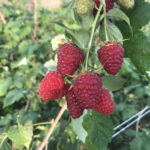
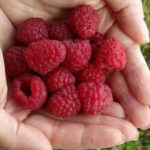



I agree, the variety is unique. Yes, it is baked, yes, regular watering is needed (without a drop, you can forget about record yields and large berries), but these disadvantages, so to speak, are covered by the many advantages of this raspberry over other varieties. Joan Jay is especially attracted by the opportunity to harvest from spring to late autumn while maintaining the excellent taste of the berry. Last year, they ate raspberries until mid-November, as the weather was favorable and -2, -3 on the ground did not ruin the harvest, because this plant can withstand frost down to -5.
This year, the abnormal heat brought it down - even with regular watering and feeding, the berries were very shallow, baked (some berries were completely white and not suitable for sale), so next year we will definitely use a shading grid.